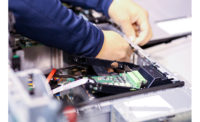On-board video storage on the edge using an SD card has gained traction lately in the video surveillance world. The main reason is that today’s SD cards offer substantially larger storage capacity at a substantially lower cost than in years past.
“A 1 GB card used to cost around $100 only a few years ago; today you can buy a 32 GB card for under $40 or $50,” shares Fredrik Nilsson, general manager for Chelmsford, Mass.-based Axis Communications. “Moore’s Law continues to push the consumer storage market forward with more capacity for less cost. Soon SD cards will be able to hold upwards of 2TB. That’s years’ worth of storage at the edge.”
In other words, storage technologies have caught up with technological advances in video.
“The capacity now fits the capabilities of video solutions, especially megapixel video,” says Willem Ryan, senior product marketing manager, video solutions, for Bosch Security, Fairport, N.Y.
Primary or Backup?
Whether on-board storage in general, or SD cards in particular, are used as primary or secondary storage largely depends on the application and the needs of a particular customer. For the most part, however, it is used as a primary storage source in only smaller installations, Ryan describes.
“If you have 100-plus cameras, there’s no way it’s going to be your primary storage, but it’s beautiful for backup if your network goes down,” he says. “Mostly we see edge storage as the primary source in the small-to-medium business (SMB) market where there are 16 cameras or less. They want to eliminate as much storage cost as possible, so that would be a case where it’s the primary source. Large enterprises really like it for backup.”
Todd Pinnell, product manager, video, at Amityville, N.Y.-based Speco Technologies, says there’s really no “typical” application, since every customer and their needs are very different. “We’ve seen it used in all different ways,” Pinnell says. “A lot of law enforcement agencies use it for primary storage, but most customers use it for backup because that’s what it’s sold as. That doesn’t mean some people don’t use it for primary storage, but a lot still want a connection to their VMS or hybrid DVR. I’d like to see more primary use; that’s the wave of the future.”
Whether your customers are using on-board storage for primary or secondary storage, it’s important to make sure you are not overtaxing the capability of SD cards in general, Ryan says.
“We advise people not to record continuously, but on an event basis. Set up parameters like recording only on motion or on a schedule. If you record continuously, you’ll run out of space very quickly,” Ryan says. This kind of constant read/write cycle will send an SD card to an early grave, he adds. (See related article, “The Weakest Link,” below.)
Rick Taylor, vice president, security division, for Mundelein, Ill.-based systems integrator Esscoe, says his firm has been offering SD card storage at the edge for about two years, and that about 25 percent of the company’s installations use the technology. Of those installations, few are using it as a primary storage source.
“We’ve found that the primary interest in storage at the edge is with the middle market to the upper market, although this solution can be pretty affordable for any customer who may have interest,” he says. “Customers are generally interested in storage on the edge, primarily as a backup solution, and our customers seem to be more comfortable with a solution that allows them to continue to record when the network or server fail.”
Another reason customers like edge storage, Taylor says, is the ability to “trickle” video from the camera to an on-site recording and storage solution during off-hours. “This gives the customer the ability to offload video from the edge to the archive during non-peak network hours; it’s a real benefit in situations where there is a limited amount of bandwidth,” he says.
Frank De Fina, vice president of sales and marketing for Ridgefield Park, N.J.-based Samsung Techwin, says that while the majority of applications are for secondary or backup storage, a customer usually has a very good reason when choosing to use on-board storage as their primary source.
“We’ve found the request of the SD backup in many applications, but when we see it in a primary role, one location has been in elevators in many buildings where there is a concern for safety but the networking on the elevator cable is typically not there or is not stable,” he says.
Size Matters
The general consensus seems to be that the most common, if not standard, SD card size for use with video surveillance today is 32 GB.
Some Bosch cameras provide support for that emerging top tier of SD cards, “but good luck finding a 2 TB card anywhere,” Ryan says. Supply will eventually catch up with demand (and vice versa), but for now, 32 GB cards are good enough for most applications, he adds.
“You have to consider how many days of storage your customer needs, what resolution and how many images per second, then calculate what you’ll get on that card,” he says. Most manufacturers offer a storage calculator on their website to help with this.
In some cases, Taylor says, there’s a tradeoff between two different technologies, so an installer and integrator has to weigh the pros and cons of each when choosing the solution that’s best for their customer.
“The pro is that you can give the customer some redundancy at a fraction of the cost of implementing redundant servers and licensing. The con is that you’re still limited in the size of the storage you have at the edge,” he says. “You can certainly gain more storage by getting away from an SD card technology and going to a camera with an actual hard drive on board and get up to a 250 GB hard drive, but once again, where there are moving parts, you have more failures and these are now way out in the field.”
Besides card capacity, there are two other important size considerations: the size of an installation and the size of the opportunity sitting out there, just waiting to be seized by savvy dealers and integrators, Nilsson says.
“On-board applications are perfect for surveillance installs of 16 cameras or less. This size installation is completely dominated by analog today,” he says. “Consider all the retail shops, small offices, banks, gas stations, restaurants, hotels and convenience stores across the country, in your state, or even in your town that need a surveillance solution. That’s a lot of IP sales and relationship opportunities for integrators.”
However, when looking for those opportunities, recognize that on-board storage is not for everyone, so it is important to ensure that the solution you are selling is the best one for your customer.
“Remember that it’s best for single-sight, less-than-16-camera solutions where the end user does not require high-end VMS functions,” Nilsson says. “If there’s a multi-site opportunity, hosted video is most likely a better option. If the customer requires more analytical data or advanced functionality, a PC- or server-based VMS system would be the right call.”
The Future
While smaller installations and lower-capacity SD cards used for secondary or backup storage are most common today, there may be a shift, similar — and not unrelated — to the analog-to-IP shift, toward more widespread acceptance and use of SD cards at the edge for primary storage, Nilsson says.
“In the past, on-board storage was more or less a nice add-on feature that could be used for redundancy in mission-critical applications or, in some unique installations, a recording option for remote cameras,” he says. “Today, with the development of new software solutions and increased capacity of SD cards, the IP camera/encoder has become the recorder in small systems.”
If capacity continues to rise and cost continues to fall, SD cards may start to creep into turf currently occupied by longstanding technologies. “As IP cameras gain more processing power, software becomes more advanced and SD card capacity continues to increase at this rate, we’ll see a major shift to the camera-as-the-DVR in the near future,” Nilsson says.
De Fina agrees, adding that some technologies may simply disappear as a result. “The new format of SDX cards will give us the ability to use up to 2 TB cards, which lend themselves to having the NVR storage application and long storage on the cameras, which should change our market dramatically,” De Fina says. “It’s a game-changer with the new format versions to give manufacturers up to 2 TB for each cameras and will eventually lead to the NVR as we know it to go away.”
The future looks bright for SD card storage at the edge, Ryan says, but there is a great unknown lurking in the wings that could derail any growth. “The only thing that could change that is the cloud, but right now it’s still a bit iffy. If you don’t have to manage any storage — on site or on the edge — that could affect the popularity and growth for some SD card storage applications,” Ryan describes. “We’re a long way from that being mainstream at this point.”
For now, however, the cloud isn’t practical, making on-board edge storage a very attractive proposition, Pinnell says.
“With the network infrastructure we have now, it’s not practical to send massive amounts of data into the cloud. We all have to wait and see. You can’t be 100 percent sure how the cloud going to work, so you can’t guess about it,” he says. “On-board storage is a wonderful technology that needs to be exploited. Acceptance of IP cameras is starting to get farther along, which is going to help push it out there.”
On-board storage solutions also should benefit from the move from analog to IP in that smaller market that is still 80 percent analog, Ryan says.
“For residential and small business applications, on-board storage brings the capability of IP to the masses. People want a system but they don’t want to spend hundreds of dollars for an NVR; this brings security to everyone,” he says.
This article was previously published as "In the Cards" in the print magazine.
The Weakest Link
Because they are made specifically for the consumer electronics world, Bosch’s Willem Ryan says, all SD cards are not created equally. And when it comes to lifetime, it’s not a question of if an SD card will fail, but when it will fail.
“In your digital camera at home, you use an SD card to record images or video on a very rare basis to semi-frequent basis, which is nowhere near the amount of recording you’re doing in security,” he says. “The more data you’re storing, the more frequently you’re reading and writing to an SD card, which means the sooner the card fails.”
There are four classes of SD cards: Class 2, Class 4, Class 6 and Class 10. The numbers refer to the card’s maximum read/write speed in terms of megabits per second. The higher the number, the faster the card’s capability. When choosing a card, it is important to remember that you get what you pay for, Ryan says, and there are some guidelines to consider.
“Do not cheap out on the type of card. At bare minimum, for standard definition, we recommend Class 4, or Class 10 if you’re using multi-megapixel cameras,” he says. “There’s a price difference, but it’s very important, especially if you’re using it as your primary recording source.”
Environment, temperature, even the location of the card slot can all negatively affect the performance and life of SD cards, says Speco Technologies’ Todd Pinnell.
“Card slots are often located in different places, and some may be more accessible than others. If a camera has a card slot on the bottom, the card is going to degrade more quickly. Then you have to essentially do an uninstall to take that camera off line, replace the card and make sure you don’t lose anything,” he says. “If you’re talking about 16 cameras, that’s a lot of time and cost.”
Ryan’s advice? Find the best available card on the market and use it, regardless of who makes it.
“When it comes to SD cards, brand is less important than class,” he says.




